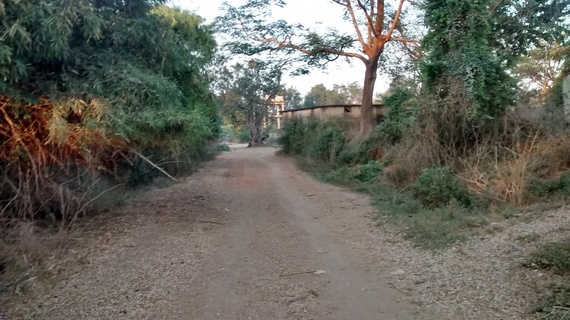
© Tushar Dhara
"Ghosts are a metaphor for memory and remembrance and metaphorically connect our world to the world we cannot know about," the fantasy writer Leslie What once said in an interview. She was referring to their use as a literary device to explore religious themes. That quote is equally valid in non-literary settings, as I discovered in my strange and disorienting visit to a "ghost" village.
Last month I got an invitation from a friend to visit him in a remote part of Maharashtra where he has been doing field work. I accepted and travelled to a small village in central India in the dying days of 2015. Ambhora is located around 80km east of Nagpur, on the banks of the Wainganga River, which originates in Madhya Pradesh and flows through Maharashtra and into the Godavari, the second longest River in India.
The number of people displaced is around 80,000 spread over 200 villages, including 93 which will go fully under water, becoming invisible or ghost villages.
The Wainganga is also the site of the Gosikhurd Dam, part of a scheme to divert river waters to irrigate nearly 2.5 lakh hectares of land in three of Maharashtra's easternmost districts. Unlike "superstar" dams like Narmada and Tehri, which have attracted reams of press publicity and passionate tracts by academics and activists, Gosikhurd is relatively unknown. The number of people displaced is around 80,000 spread over 200 villages, including 93 which will go fully under water, becoming invisible or ghost villages. It is the last category of village that entranced me the most during my short visit.

© Tushar Dhara
Ambhora is a village that has been abandoned, left to the ghosts. Only memories and remembrance are left. All the people are gone. The houses are breaking and nature is reclaiming the habitation. The village lies on the banks of the Wainganga and in more habitable times, in the not too distant past, boys played cricket and held wrestling matches on the sandy banks. As the water level rose due to the damming of the river families started leaving. Ambhora has not disappeared, yet, but the water is not far away.
I was startled to see a standing settlement, empty and silent. The road that led into the village was deserted. The magnificent banyan tree at the head of the village was once the community centre. Elders gathered under it to smoke a hookah and exchange gossip while children played under the ample shade and used the hanging roots to swing. In Indian mythology the banyan is associated with Yama, the god of death and is considered to be the abode of ghosts. As I sat under the banyan tree and stared up into the thick foliage I could feel the ghosts connecting me to a world that I hardly knew.

© Tushar Dhara
The picturesque Wainganga originates in the forests of Madhya Pradesh. Rudyard Kipling used it as the setting for the events in the Jungle Book, which he populated with tigers, wolves, leopards, bears and a "man cub". The fantasy of a colonial writer was able to yield exotic stories, but the reality is far more complex.
Vidarbha, where Gosikhurd is situated, is economically backward compared to western Maharashtra. Moreover, it is contiguous with the resource-rich parts of central India, where a mix of poverty, unemployment and exploitation has given rise to support for the Maoists, left-wing extremists locked in a violent struggle with the police. Vidarbha is also ground zero for farmer suicides. It is in such a socio-economic context that the Gosikhurd dam needs to be located. The logic of situating an irrigation project here was to address inequality and poverty, according to the Maharashtra government.
Figures compiled by groups working in the area indicate that 80% of the affected social groups by the Gosikhurd project are from socially and economically deprived sections.
Ramachandra Guha notes in an essay that since 1950, perhaps as many as 20 million Indians have been ousted by new hydro-electric projects, mines and factories. The displaced have disproportionately been small peasants, whereas the schemes have benefited the urban middle and upper classes and farmers with large landholdings. Figures compiled by groups working in the area indicate that 80% of the affected social groups by the Gosikhurd project are from socially and economically deprived sections.
The dam is intended to benefit 718 villages across three districts by bringing new land under irrigation, according to official documents, and a simple cost-benefit analysis would rule in favour of the dam. The "Temples of Modern India" logic of big dams, forged during the foundational years of the Indian republic, believed that scientific and industrial progress were essential for development. Whether such projects could deliver social justice and were ecologically sustainable was not considered.
Today the notion of dams as "social saviours" is under serious doubt, plagued by human rights and environmental concerns. The Gosikhurd dam was conceived in the 1980s, when such concerns were not yet fully articulated.
"The more enlightened our houses are, the more their walls ooze ghosts. Dreams of progress and reason are haunted by nightmares," Italian novelist Italo Calvino once said. The ghosts ooze out of every wall in the abandoned village of Ambhora. What they say about progress and reason are worth listening to, if you care to listen.

© Tushar Dhara
 Like Us On Facebook |
Like Us On Facebook |  Follow Us On Twitter |
Follow Us On Twitter | Also see on HuffPost: